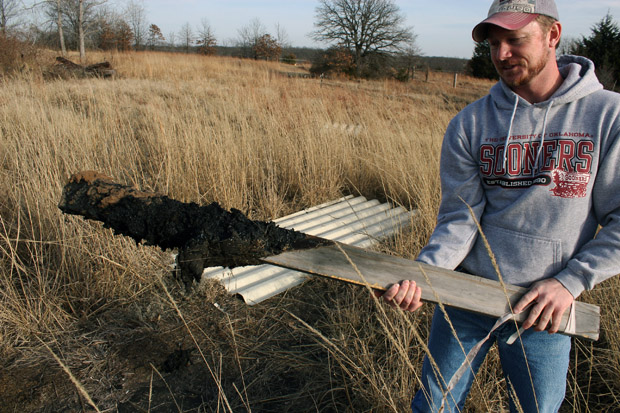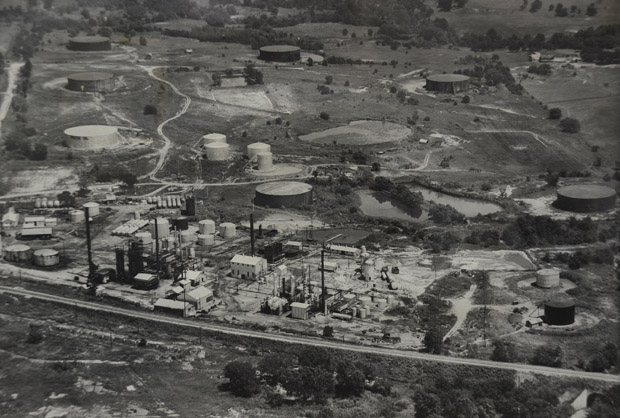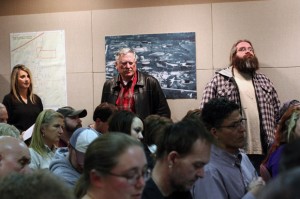Cleanup of Hazardous Oklahoma Refinery Site Went Unfunded Until People Moved In
-
Joe Wertz

Joe Wertz / StateImpact Oklahoma
Tyler Lane pulls up a wooden marker covered with oily sludge in the land behind his Bristow home. Lane uses stakes and rope to keep his two children out of the oiliest, most dangerous parts of his property, which sits atop the abandoned Wilcox Refinery, Oklahoma’s newest Superfund site.
You can’t see it from street, or when you look out the window of Glen Jones’ parents’ house, but the Wilcox Refinery is still here. Parts of it, anyway.
In December 2013, the abandoned refinery complex near Bristow became Oklahoma’s newest federal Superfund site. The Wilcox Refinery closed more than 50 years ago, but lead and other toxic chemicals remain, and residents are uneasy about the long cleanup ahead.

Oklahoma Department of Environmental Quality
The Wilcox and Lorraine refineries operated at the 125-acre Bristow Superfund site. The complex was abandoned in 1963. The cleanup was crude, and much of the oily sludge, waste and equipment was simply buried.
Complex Cleanup
“See the black stuff all over the rocks and all over the leaves,” Jones says, walking alongside a creek bed behind the modest home. “Kinda looks like crude, don’t it?”
The complex was home to the Wilcox and Lorraine refineries and opened shortly after statehood. The small town, now home to about 4,200, welcomed the jobs and the refineries’ role in helping bring to market the riches of Oklahoma’s first oil boom.
The refinery was employing about 75 locals who were helping process about 5,500 barrels of oil a day when it closed in the mid-‘50s. Another oil company bought the refinery with the hopes of re-opening it, but gave up, and the site was abandoned in 1963.
Efforts to decommission the complex — which included a cracking and skimming plant and batteries of storage tanks, and pits of oily sludge and waste — were, in a word, crude.
“They said the tanks were here, and they just bulldozer-ed over the top of them,” Jones says, pointing out corroded metal pipes poking out of the ground, and half-buried bits of rusting machine parts. “There’s stuff all through this ground, we just don’t know it.”

Joe Wertz / StateImpact Oklahoma
Bristow residents packed the public library during a January 2014 town-hall meeting, where officials from the Oklahoma Department of Environmental Quality and U.S. Environmental Protection Agency explained the Superfund cleanup process and answered questions.
“I’ve had it all over me”
The Oklahoma Department of Environmental Quality and representatives from the U.S. Environmental Protection Agency hosted a town hall at the Bristow Pubic Library in January to explain the Superfund cleanup process and answer questions.
Residents packed the room and spilled into the library’s foyer, where overflow seating was added. Monty Elder, public land participation officer with the Oklahoma Department of Environmental Quality, gave a presentation about the history of the Wilcox Refinery site, and detailed some of the site’s environmental hazards.
When the refinery opened in 1915, the oil industry health officials “weren’t even aware of environmental problems,” she told the crowd.
Worried residents, like Rachel Lane, took turns at the microphone. When Lane and her husband, Tyler, bought their home, they thought they were buying a farm — not a tank farm.
“We’ve got the actual sludge — or whatever you want to call it — coming up,” Rachel says.
Prior to the meeting, Tyler Lane gave me a walking tour of their land around their home. He has strung rope across the property keep their kids out of the oily sludge. The worst spots are marked with wooden stakes. When you pull on them, the ground heaves and oozes.
The EPA estimates a dozen other people live within the boundaries of the old refinery site. Another 5,000 live within two miles. A full survey hasn’t been completed, but environmental officials say the soil and a nearby creek are likely contaminated with copper and lead, and powerful atmospheric pollutants called polycyclic aromatic hydrocarbons.
“What should we do if we come into contact with that,” Rachel asked the environmental officials at the town hall. “Because my dogs have been in it. I’ve bathed them, so I’ve had it all over me. I have a 2 and a 5-year-old out playing — you never know.”

Joe Wertz / StateImpact Oklahoma
Monty Elder, public land participation officer with the Oklahoma Department of Environmental Quality, answers residents’ questions about environmental hazards at the Wilcox Refinery site.
“Abandoned and Uncontrolled”
Oklahoma’s Department of Environmental Quality was created in 1993. A year later, environmental officials there started trying to get the federal government to give the Wilcox Refinery site Superfund status. This designation is the only way “abandoned, uncontrolled, hazardous” waste sites in Oklahoma ever get cleaned up. Monty Elder with the DEQ told the town hall crowd why.
“The state of Oklahoma does not have any money to clean up sites,” Elder says. “There’s not a pot of money out there. The legislature hasn’t given us money.”
The EPA’s equation for determining which of the country’s hazardous waste sites are declared Superfund projects is based on human health hazards, Elder and other DEQ and EPA officials say. In the ’90s, there weren’t enough people living near Bristow’s abandoned refinery to make the cut, so nothing was done.
Decades later, with no obvious signs of the environmental hazards, the Lane and Jones families — and others — moved in, on top of a toxic waste site they couldn’t see. Because they moved in, there’s a human health risk and federal funding, so the cleanup can begin.
